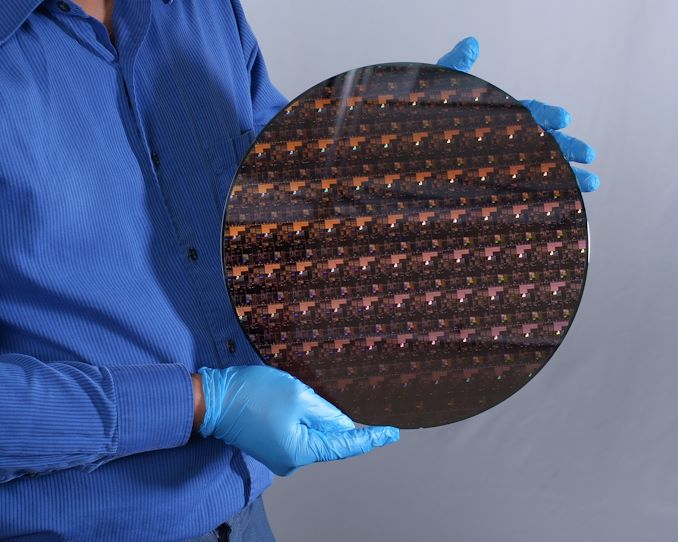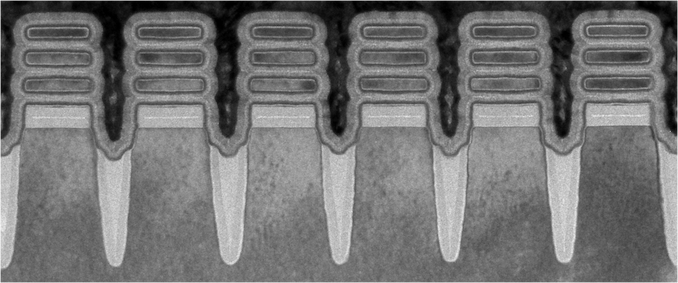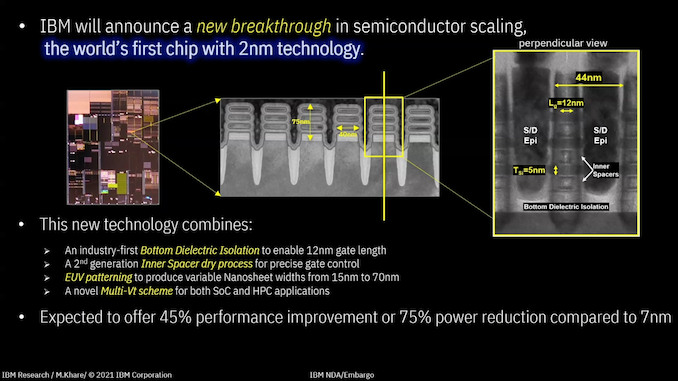IBM Creates First 2nm Chip
by Dr. Ian Cutress on May 6, 2021 6:00 AM EST
Every decade is the decade that tests the limits of Moore’s Law, and this decade is no different. With the arrival of Extreme Ultra Violet (EUV) technology, the intricacies of multipatterning techniques developed on previous technology nodes can now be applied with the finer resolution that EUV provides. That, along with other more technical improvements, can lead to a decrease in transistor size, enabling the future of semiconductors. To that end, Today IBM is announcing it has created the world’s first 2 nanometer node chip.
Names for Nodes
Just to clarify here, while the process node is being called ‘2 nanometer’, nothing about transistor dimensions resembles a traditional expectation of what 2nm might be. In the past, the dimension used to be an equivalent metric for 2D feature size on the chip, such as 90nm, 65nm, and 40nm. However with the advent of 3D transistor design with FinFETs and others, the process node name is now an interpretation of an ‘equivalent 2D transistor’ design.
Some of the features on this chip are likely to be low single digits in actual nanometers, such as transistor fin leakage protection layers, but it’s important to note the disconnect in how process nodes are currently named. Often the argument pivots to transistor density as a more accurate metric, and this is something that IBM is sharing with us.
Transistor Density
Today’s announcement states that IBM’s 2nm development will improve performance by 45% at the same power, or 75% energy at the same performance, compared to modern 7nm processors. IBM is keen to point out that it was the first research institution to demonstrate 7nm in 2015 and 5nm in 2017, the latter of which upgraded from FinFETs to nanosheet technologies that allow for a greater customization of the voltage characteristics of individual transistors.
IBM states that the technology can fit ’50 billion transistors onto a chip the size of a fingernail’. We reached out to IBM to ask for clarification on what the size of a fingernail was, given that internally we were coming up with numbers from 50 square millimeters to 250 square millimeters. IBM’s press relations stated that a fingernail in this context is 150 square millimeters. That puts IBM’s transistor density at 333 million transistors per square millimeter (MTr/mm2).
For comparison:
| Peak Quoted Transistor Densities (MTr/mm2) | ||||
| AnandTech | IBM | TSMC | Intel | Samsung |
| 22nm | 16.50 | |||
| 16nm/14nm | 28.88 | 44.67 | 33.32 | |
| 10nm | 52.51 | 100.76 | 51.82 | |
| 7nm | 91.20 | 237.18* | 95.08 | |
| 5nm | 171.30 | |||
| 3nm | 292.21* | |||
| 2nm | 333.33 | |||
| Data from Wikichip, Different Fabs may have different counting methodologies * Estimated Logic Density |
||||
As you can tell, different foundries have different official names with a variety of densities. It’s worth noting that these density numbers are often listed as peak densities, for transistor libraries where die area is the peak concern, rather than frequency scaling – often the fastest parts of a processor are half as dense as these numbers due to power and thermal concerns.
With regards the movement to Gate-All-Around / nanosheet transistors, while not explicitly stated by IBM, images show that this new 2nm processor is using a three-stack GAA design. Samsung is introducing GAA at 3nm, while TSMC is waiting until 2nm. Intel by contrast, we believe, will introduce some form of GAA on its 5nm process.
IBM’s 3-stack GAA uses a cell height of 75 nm, a cell width of 40 nm, and the individual nanosheets are 5nm in height, separated from each other by 5 nm. The gate poly pitch is 44nm, and the gate length is 12 nm. IBM says that its design is the first to use bottom dieletric isolation channels, which enables the 12 nm gate length, and that its inner spacers are a second generation dry process design that help enable nanosheet development. This is complimented by the first use of EUV patterning on the FEOL parts of the process, enabling EUV at all stages of the design for critical layers.
Users might be wondering why we’re hearing that IBM is the first to a 2nm chip. IBM is one of the world’s leading research centers on future semiconductor technology, and despite not having a foundry offering of their own, IBM develops IP in collaboration with others for their manufacturing facilities. IBM sold its manufacturing to GlobalFoundries with a 10 year partnership commitment back in 2014, and IBM also currently works with Samsung, and recently announced a partnership with Intel. No doubt the latter two will be partnering with IBM on some level around this new development for its viability in their own production chain.
No details on the 2nm test chip have been provided, although at this stage it is likely to be a simplified SRAM test vehicle with a little logic. The 12-inch wafer images showcase a variety of different light diffractions, which likely points to a variety of test cases to affirm the viability of the technology. IBM says that the test design uses a multi-Vt scheme for high-performance and high-efficiency application demonstrations.
The chip was designed and made at IBM’s Albany research facility, which features a 100,000 sq. ft. clean room. The purpose of this facility is to build on IBM’s expansive patent and licensing portfolio for collaborations with partners.
We have a set of questions with IBM’s experts awaiting response. We also now have an active invitation to go visit, as and when we can travel again.
Related Reading
- IBM and AMD to Advance Confidential Computing
- Hot Chips 2020 Live Blog: IBM z15, a 5.2 GHz Mainframe CPU (11:00am PT)
- IBM & Partners to Fight COVID-19 with Supercomputers, Forms COVID-19 HPC Consortium
- Hot Chips 31 Live Blogs: IBM's Next Generation POWER
- IBM to use Samsung 7nm EUV for Next-Gen POWER and z CPUs
- IBM And Everspin Announce 19TB NVMe SSD With MRAM Write Cache
- TSMC Update: 2nm in Development, 3nm and 4nm on Track for 2022
- Intel’s Manufacturing Roadmap from 2019 to 2029: Back Porting, 7nm, 5nm, 3nm, 2nm, and 1.4 nm














118 Comments
View All Comments
jsz - Thursday, May 6, 2021 - link
I just know the I/O die is finnicky and sensitive when running high speed ram, granted, I wouldn't rule out faulty chips.Silver5urfer - Monday, May 10, 2021 - link
More than those WHEA RMA BSODs the bigger issue with X570 is the USB problems on the chipset. It's not fixed with the latest AGESA. People still have that damn issue, fck even Optimum Tech guy mentions that he has a problem with USB on his main rig which is a 5900X and an Nvidia RTX 3090 FE on Custom Loop.That issue is not going to be fixed for sure, my guess AMD fucked up the QC on their chipset and processors and boosted them to max and failed to provide a proper validation on top you don't have any friggin documentation on the AMD processors. ZERO.
Kuhar - Friday, May 7, 2021 - link
I am a happy AMD user aswell. Every day use of machine, regular stuff like surfing, documents and spreadsheets, very little programming and some quite serious gaming and everything work great.When i build my machine i always check EXACTLY what RAM is supported by my motherboard. I guess that can be the reason for problems for many people - they just check memory speed and that is all. Nope, that is not all, unfortunatelly.
Beaver M. - Sunday, May 9, 2021 - link
There are a lot of people who get WHEA errors and crashes stock. They replaced the CPU and it worked. Some had to replace twice or three times before it worked.AMD has issues, but the fanboy force is just too powerful. They will defend everything.
Remember when the USB issues (which had been going on for years) made the big news. All of the sudden thousands of people spoke up.
IDK what it is with AMD fanboyism, but its not good for AMD.
Qasar - Monday, May 10, 2021 - link
and the intel fanboy force is just as bad, intel has had their own issues over the years.shabby - Thursday, May 6, 2021 - link
4th word is the answer.Peskarik - Thursday, May 6, 2021 - link
In which sense am I lying?Is this a lie:
https://community.amd.com/t5/processors/ryzen-5900...
https://www.overclock.net/threads/replaced-3950x-w...
Or you are telling me I do not have BG 2110PGS , 100-100000061WOF lying in front of me as I type this?
Qasar - Thursday, May 6, 2021 - link
like machinus said, ill buy that cpu from you.Peskarik - Thursday, May 6, 2021 - link
Too much hassle. I still have 3 weeks to return it to the shop. I am not decided yet if I want to take my chances on it being one of the problematic ones or not.the_eraser1 - Thursday, May 6, 2021 - link
I have purchased a 5600X, 2 of 5800X, a 5900X, and a 5950X. All of them have worked out of the box, and with particularly taxing 4-stick (dual rank) Samsung B Die that I have overclocked to 3733 14-15-14.There are bad samples, yes. But that applies to anything.